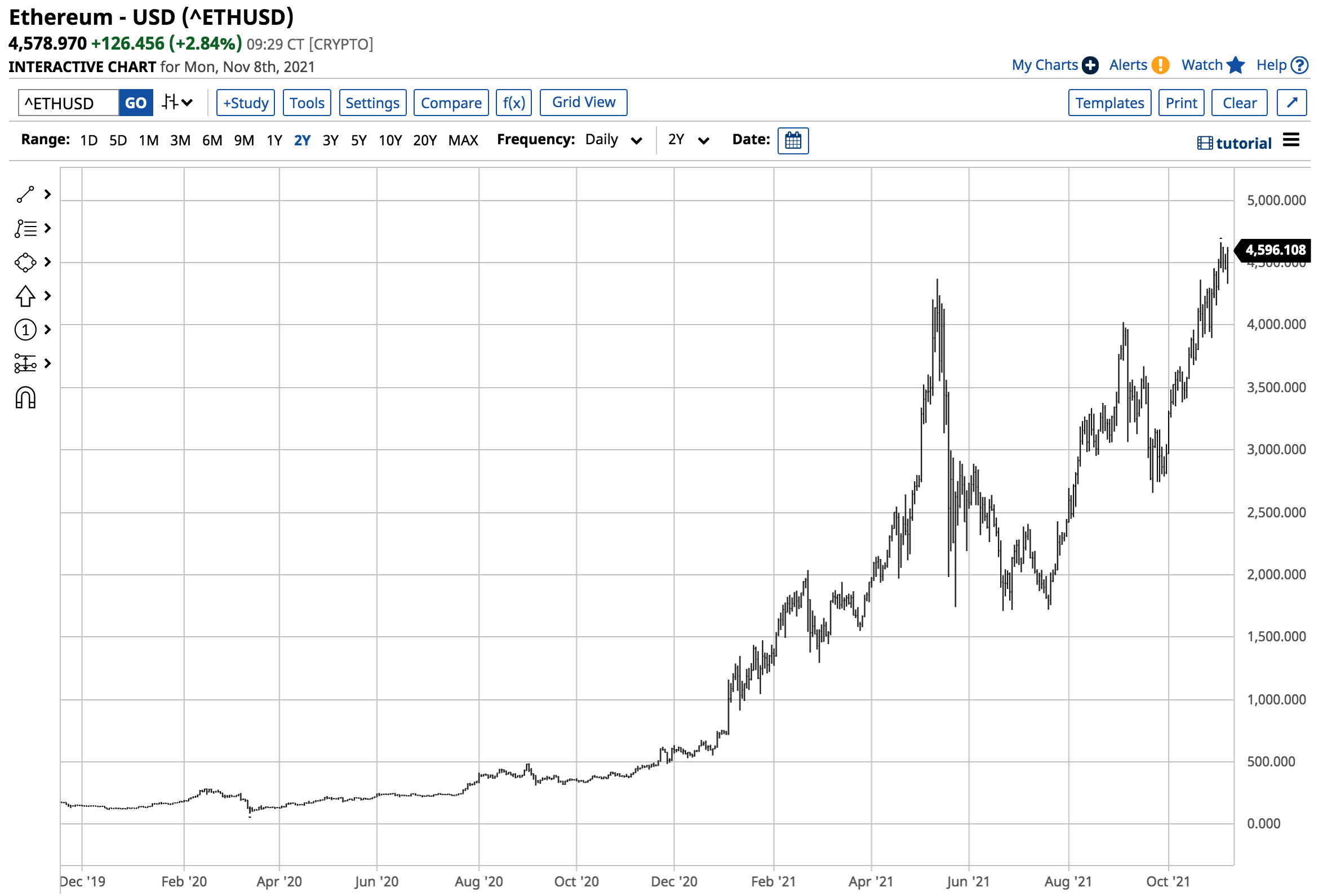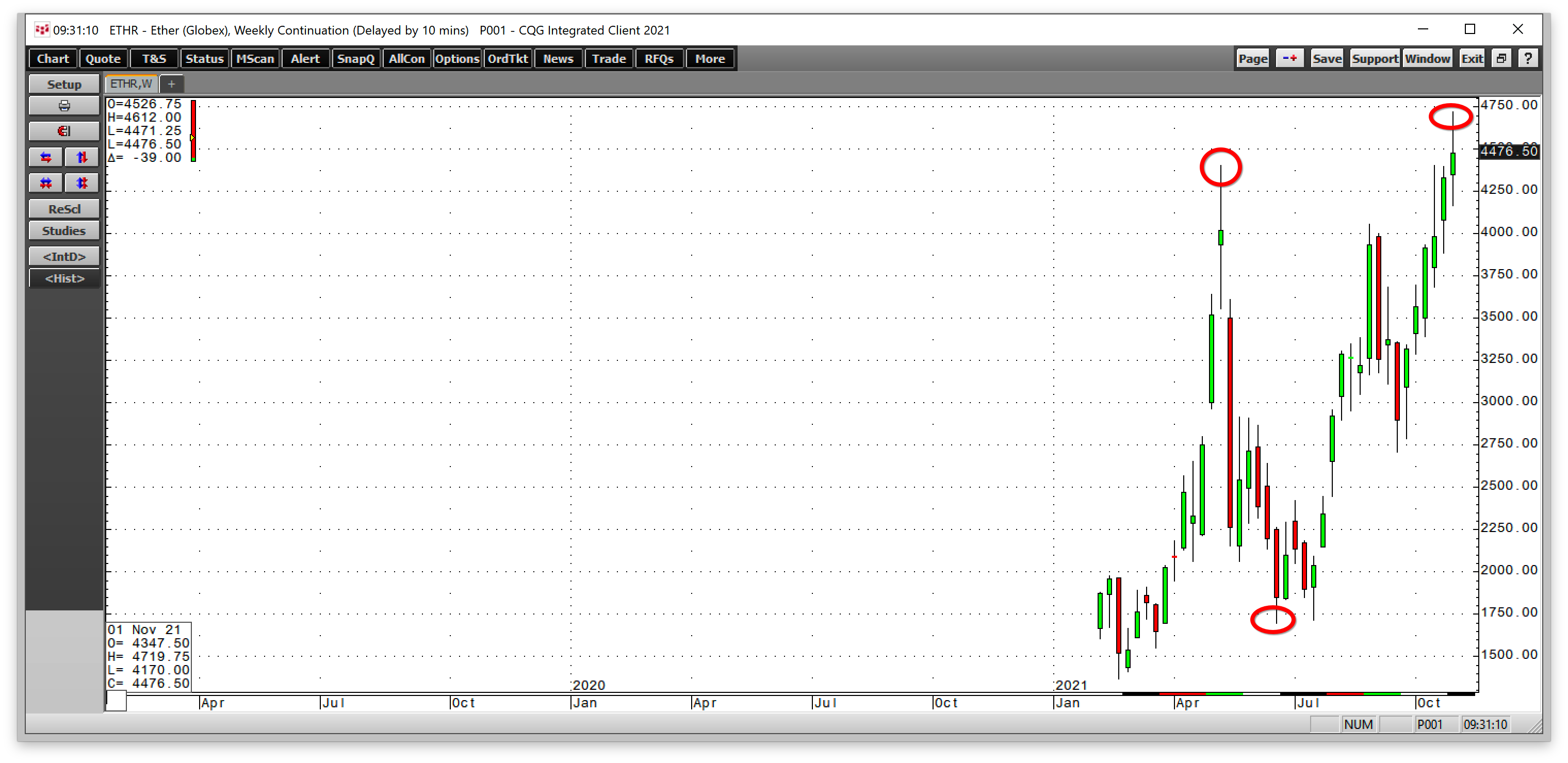+22% in a single week as markets remain flat: These are December’s hidden winners
This article was written exclusively for Investing.com
- One of the best-performing liquid assets of 2021
- New highs in Ether
- Ethereum: highly flexible crypto protocol
- The trend is always our friend; cleaner and greener trend is even friendlier
- Beware however—risks rise with the price
Whatever you may think about the cryptocurrency asset class, the rise has been nothing short of incredible. Thirteen years ago, Bitcoin was nothing but a notion in the head of Satoshi Nakamoto—whomever he, she or they are—who published a white paper. That work set the stage for Bitcoin and blockchain that is the essence of fintech, technology’s impact on finance.
In 2010, anyone could have bought a Bitcoin token for as little as five cents. At the over-$61,000 level at the end of last week, anyone who invested one dollar then is a millionaire now.
Aside from the financial gains, the growing acceptance of cryptocurrencies has gripped markets, regulators, and government officials. Cryptos reject government control of the money supply and return it to individuals. They are the ultimate libertarian means of exchange.
Many high-profile operators in the technology sector, including Jack Dorsey, CEO of both Square (NYSE:SQ) and Twitter (NYSE:TWTR), Tesla’s (NASDAQ:TSLA) Elon Musk, Meta Platforms' (NASDAQ:FB) Mark Zuckerberg, and others, have embraced the burgeoning asset class.
Naysayers, including JP Morgan’s (NYSE:JPM) Jamie Dimon, Berkshire Hathaway's Warren Buffett and Charlie Munger (NYSE:BRKa), and a host of additional investors and bankers, have expressed disdain for the asset class, as they are the keepers of the status quo.
Government officials have challenged cryptos based on their use in ransomware and other nefarious activities, but that likely masks an underlying concern about control of the money supply, a root of power.
Bitcoin remains the leader of the crypto pack, but Ethereum is hot on its heels. Last week, the second-leading crypto achieved a milestone as the value of the digital token rose to a new record high.
One of the best-performing liquid assets of 2021
As of Friday, Nov. 5, 2021, Ethereum’s appreciation has been nothing short of incredible. 
Source: Barchart
The chart shows that Ethereum moved from $738.91 on Dec. 31, 2020, to the $4500 level at the end of last week. Ethereum delivered returns that were over six times higher than the price at the end of last year. At time of publishing, the cryptocurrency has moved even higher, currently trading at $4,715.
Meanwhile, Bitcoin rose from $28,986.74 at the end of 2020 to the $61,290 level as of Nov. 5, a 111.4% gain.
New highs in Ether
It has been a fantastic year for Ethereum investors who have held on for a wild ride in the second-leading cryptocurrency. The Chicago Mercantile Exchange rolled out Ethereum futures in February 2021 and is still the only cryptocurrency other than Bitcoin that trades on the CME. Since the introduction of futures, Ethereum has provided a wild and head-spinning ride.

Source: CQG
As the chart highlights, Ethereum futures reached a peak at $4,406.50 during the week of May 10 before losing over half their value and falling to a low of $1,697.75 in late June. The decline turned out to be another golden buying opportunity as Ethereum futures eclipsed the May high last week, rising to $4,719.75 on the nearby futures contract and closing around the $4,500 per token level at the end of last week. Currently futures are hovering just below the $4,783 level.
Ethereum: highly flexible crypto protocol
Thirteen years ago, Bitcoin and blockchain technology emerged at the same time as Satoshi Nakamoto issued a white paper that described and outlined the first cryptocurrency. Ethereum followed Bitcoin’s steps as a ledger technology that companies use to build new programs.
In the world of financial technology or fintech, Bitcoin was the 1.0 version of the asset class; Ethereum is crypto 2.0, allowing for building decentralized applications built on top of the Ethereum platform.
The main improvement Ethereum offers compared to Bitcoin is it allows individuals and companies to do much more than just transfer money between entities. Think of it this way, if Bitcoin is a competing means of exchange, Ethereum is a complete financial infrastructure around money.
The trend is always our friend; cleaner and greener is even friendlier
The trend may be volatile and hair raising as the ascent continues, but it remains higher. The volatility is likely to continue too.
While proponents like Square’s Jack Dorsey believe cryptocurrencies will “unite the world,” opponents like Charlie Munger call them “disgusting and contrary to the interests of civilization.” Warren Buffett has called them “financial rat poison squared.”
Governments are not all that fond of the asset class either. While they state that regulators need to “protect the public,” addressing custody, security, and manipulation issues, the underlying motivation is preserving the status quo that allows for governmental control of the money supply.
Meanwhile, the cryptocurrency asset class keeps expanding by leaps and bounds. At the end of last week, the market cap of over 13,600 cryptos stood at the $2.683 trillion level. Ethereum’s market cap at around $530 billion was nearly 20% of the entire market, second only to Bitcoin with an over $1.15 trillion value.
High-profile public relations efforts from technology leaders have only increased interest in cryptocurrencies. The world’s wealthiest individual, Elon Musk, is a huge supporter of the asset class. He has had an on-again, off-again affair with Bitcoin. At first, he approved Bitcoin payments for Tesla’s EVs before backtracking. On second thought, Elon realized that Bitcoin’s carbon footprint from mining ran counter to Tesla’s mission of reducing carbon emissions.
Ethereum is a cleaner and greener crypto than Bitcoin. More Ethereum transactions per block lead to a far lower carbon footprint compared to the Bitcoin blockchain. Moreover, Ethereum’s creator, Vitalik Buterin, confirmed Ethereum would go through a complete overhaul in 2021, reducing energy consumption by almost 99%, making Ethereum 2.0 far more environmentally friendly than Bitcoin.
Ethereum is far from the greenest crypto though. The three leading green cryptos these days are Algorand (ALGO), BitGreen (BITG), and Cardano (ADA).
Ethereum appears to be doing everything right, leading to an over six times gain in 2021 compared with Bitcoin’s 111% increase since the end of 2020.
Beware, however—risks rise with the price
New tokens are coming to market each day. Whether the overall asset class’s market cap increases or decreases, the number of tokens keep growing. The count stood at the 13,606 level as of Nov. 5.
Many, if not most, of these tokens, will wind up as dust collectors in crypto wallets. Even for the leading cryptos such as Bitcoin, Ethereum and others with robust market caps, there is still a great deal of risk. The higher prices rise, the higher the risk becomes, as we witnessed in April and May when Bitcoin and Ethereum pushed to new highs before halving in value.
Hedge fund manager and billionaire investor Ray Dalio said that if the asset class continues to grow and Bitcoin is really successful, regulators will “kill it.” Time will tell if the market’s collective will is greater than the government’s regulatory powers.
Be careful when approaching all cryptos, from the leading tokens to the new arrivals. When it comes to the leadership battle between Bitcoin and Ethereum, the second-leading crypto has a leg up. Its utility and the plans for a greener token should continue its trend of outperformance.
